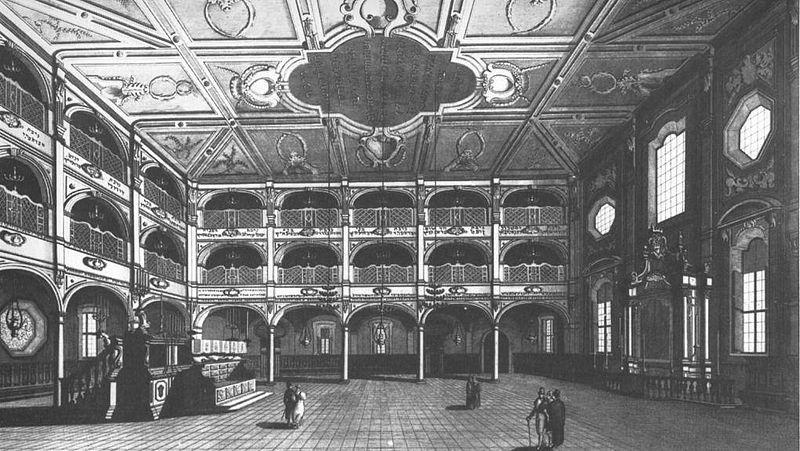Livorno's Synagogue in the 19th Century
(wikimedia
commons)
Duccio Filippi, Ed.1
Per una storia della Comunità ebraica di Livorno
Contributo bibliografico (1706-2019)
In Nuovi Studi Livornesi XXV (1-2)
Livorno, IT: Media Print, 2019. 272 pp. ISSN: 1591-7770
Reviewed by David Navarro 2
The development of the Sephardic community in Livorno, or Liorna as known in Judeo-Spanish, was closely related to the establishment of the free port in 1593. In that year the Grand Duke of Tuscany invited to Livorno merchants from any nation – particularly Jews exiled from the Iberian Peninsula – offering them rights and shelter. The city became a haven for many Sephardim who soon became numerous and influential within the city’s society. The establishment of the Livornese nazione ebrea peaked between 1530 and 1650, exemplifying a “particularly extraordinary ‘success story’ of Jewish readmission in the eyes of both Jewish and non-Jewish observers.”3 The history of the Livorno Jewish community and its achievements, challenges and upheavals has been a research topic widely studied among academics. Duccio Filippi, former director of the Labronica Library and the Cultural Institutes of the Municipality of Livorno, is the editor of Per una storia della Comunità ebraica di Livorno. Contributo bibliografico (1706-2019), a bibliographical monographic issue of the periodical Nuovi Studi Livornesi (a. XXV, n. 1-2). The work is part of a large assignment entitled Un tesoro disvelato [A treasure unveiled] designed to enhance Jewish cultural heritage of Livorno. This project, which began a few years ago, has given rise to tangible results to the census, cataloging and enhancement of the community’s cultural heritage. This material is available online for public access through the Livorno Documentary System (OPAC) and the Livorno Labronica Library.
The origins of this bibliographical volume on the Livornese Jews grew from a suggestion by former city Rabbi Alfredo Sabato Toaff, who in his 1955 introduction to his community titled “Historical Notes on the Jewish Community and the Synagogue of Livorno” opened with these words:
A chi legge. La storia completa della Comunità ebraica di Livorno, che ancora si attende, meriterebbe di essere scritta. È una storia singolare, direi quasi d’eccezione, sia per le condizioni di privilegio che gli Ebrei godettero in questo porto del Granducato di Toscana, sia perché non è soltanto d’interesse locale, non si restringe al gruppo che abitava la spiaggia tirrenica, ma interessa quasi tutto il mondo ebraico perché si riannoda con la storia politica, del commercio e della cultura dell’ebraismo mondiale. (21)
[To the reader. The complete history of the Jewish community of Livorno, which is still awaited, deserves to be written. It is a singular story, I would say almost exceptional, both for the privileged conditions that the Jews enjoyed in this port by the Grand Duchy of Tuscany, and because it did not only reach a local interest, it did not restrict itself to the group that inhabited the Tyrrhenian beach, but it affected almost the entire Jewish world because it rekindles itself with the political, commercial and cultural history of world Judaism].
That invitation was received by many researchers, especially in the last decades of the twentieth and the early twenty-first centuries, when the academic interest about the history of the Jewish community of Livorno had greatly increased both in Italy and abroad. The large bibliography collected in this volume, consisting of 1014 entries, demonstrates the strong rise in historiographic production on the Livornese Jews, and reflects the role it has played in both the civil and economic development of the city, its own identifying component, and the active commercial networks established in the Mediterranean where the rest of Sephardim communities settled on its shores, in the Middle East, and India. The volume is presented in the form of traditional bibliography (i.e. an accurate and systematic collection of bibliographical references on the subject), numbered from the newest publication to the oldest (2019 until 1706). It contains material published in the form of manuscripts, articles, periodicals, digital resources, and conference presentations not yet printed. The emergence of such an important research compilation has been possible thanks to international exchange and scientific documentation platforms. The digital sources have also been included in the form of the bibliographic records, to help provide access to these documents. These entries are supplemented by accurate reviews of the titles compiled and include three large indexes: the names of authors, editors and reviewers; the titles of volumes, essays, reviews and digital contributions; and titles of miscellaneous and periodical works.
In addition to the extensive bibliography, the volume contains images of treasures and ceremonial art of Jewish life in Livorno: various pictures of the exterior of the Sinagoga antica, the interior of the temple showing the tevah and the Aron haKodesh, several sefer torah mantles and clothing, a ketubah dated 1705, and the original draft of the Privilege to the Jewish and other merchants (the Livornine) signed by Grand Duke Ferdinando I of Tuscany dated July 1st, 1591.
This superb bibliographical work represents an open door to invite exploring and appreciating the rich cultural, social, economic, and religious life of Livornese Jews and at the same time to expand and discover new lines of research of such a singular, eclectic and particular diaspora of the Jewish world.
1
Duccio Filippi, is the former director of the Biblioteca Labronica and the Istituti Culturali del Comune di Livorno, Italy. He has extensively written
on the cultural life of Livorno during the 16th and 17th centuries, including his manuscripts
La Fabbrica del ‘Goldoni’: Architettura e cultura teatrale a Livorno(1658-1847) in 1989, and
Dal restauro al museo: Opere dalle Collezioni civiche per la storia della città in 1990.
2
David Navarro is an Associate Professor of Medieval Iberian Literature at Texas State University, San Marcos, Texas.
3
Bregoli, Francesca. “The Port of Livorno and its ‘Nazione Ebrea’ in the Eighteenth Century: Economic Utility and Political Reforms.”
Quest. Issues in Contemporary Jewish History. Journal of Fondazione CDEC 2 (2011): 47.

